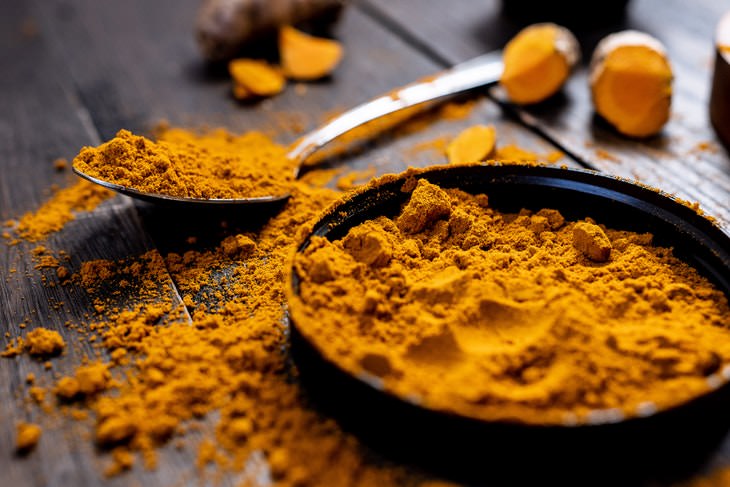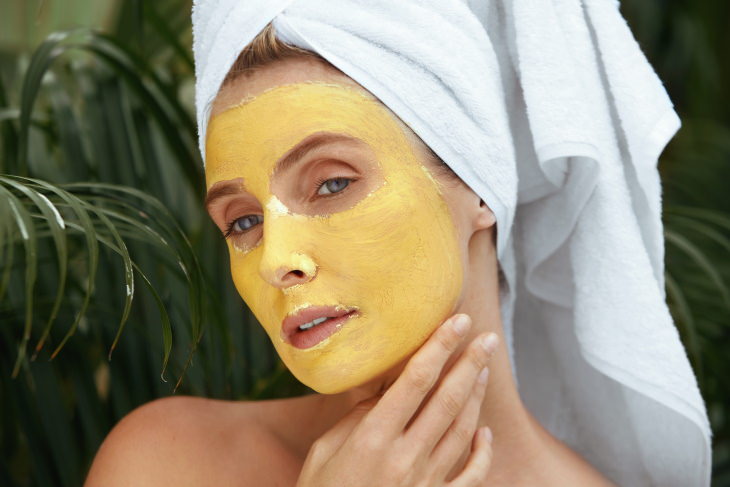One simply cannot ignore turmeric, for its
multitude of health benefits are, certainly, impressive. But we won’t
focus on those in this article - you can learn all about them in our
post titled Turmeric is As Effective as 14 Other Drugs Combined. Let’s
talk about the annoying part of this powerful spice - the staining.
It’s no secret that cooking with turmeric
is a risky business. One wrong move, and you’ll have a bright yellow
stain on your T-shirt, the kitchen counter, or even cooking utensils.
Turmeric stains can be quite stubborn, so much so that turmeric is
frequently used as a dye. But don’t let these pesky stains stop you from
using this delicious and nutritious spice.
After all, for every problem, there is a solution. And in this article,
we’ll show you how to get rid of those distinctive turmeric stains from
various surfaces - fabrics, furniture, ceramic, and even the skin.
Coincidentally, all these tips help remove stains of condiments and
sauces that contain turmeric (like mustard and curries) from these
surfaces too.
1. How to remove turmeric stains from cookware
 Turmeric can stain bowls, dishes,
containers, cutting boards, and even silicone spatulas, so be careful
when cooking with this spice at home. It does NOT, however, stain
stainless steel and ceramic, or at least not permanently, so using metal
and ceramic cookware, containers, and utensils is your best bet.
Turmeric can stain bowls, dishes,
containers, cutting boards, and even silicone spatulas, so be careful
when cooking with this spice at home. It does NOT, however, stain
stainless steel and ceramic, or at least not permanently, so using metal
and ceramic cookware, containers, and utensils is your best bet.
 Turmeric can stain bowls, dishes,
containers, cutting boards, and even silicone spatulas, so be careful
when cooking with this spice at home. It does NOT, however, stain
stainless steel and ceramic, or at least not permanently, so using metal
and ceramic cookware, containers, and utensils is your best bet.
Turmeric can stain bowls, dishes,
containers, cutting boards, and even silicone spatulas, so be careful
when cooking with this spice at home. It does NOT, however, stain
stainless steel and ceramic, or at least not permanently, so using metal
and ceramic cookware, containers, and utensils is your best bet. When it comes to plastic, wood, silicone,
glazed ceramic, or even glass kitchenware, it’s a different story
altogether, and getting rid of them will require more effort. Follow
these steps to get rid of persistent turmeric stains from cookware:
1. Rinse the dish, utensil, or container with warm water.
2. If the item is small, fill the sink with a solution of 1 part bleach
(or vinegar) and 2 parts water. Soak the stained items in the solution
for 12 hours or overnight.
3. If the item is big, saturate a cloth with the same solution, and
place it over the stain overnight.
4. Rinse the item thoroughly and proceed to clean it in the dishwasher
or by hand as usual.
If the stain remains, here’s another method you can try. This trick
works especially well for removing turmeric stains from wooden chopping
boards.
1. Mix baking soda and water into a thick paste.
2. Massage the paste into the stain and leave it for 15-20 minutes.
3. Rinse thoroughly and proceed to clean the item in the dishwasher or
by hand as usual.
2. How to get rid of turmeric stains from clothes and carpets
Even if you don’t cook with turmeric and
need not worry about your cookware gaining a yellow tinge, you may still
end up with a curry stain on your clothing, couch, or carpet when
ordering takeout. But before you proclaim your shirt, kitchen towel, or
carpet ruined, let us assure you that getting turmeric out of fabrics is
possible, especially if you act quickly.
Here’s where these step by step tips come into play:
1. Remove any excess curry or turmeric from the fabric with a paper
towel or spoon.
2. Rinse the fabric under a stream of cold water. Do NOT use hot or warm
water because this will set the stain.
3. Depending on the size of the item, fill either a sink or a bathtub
with cold water and add the appropriate amount of a stain remover (e.g.
Vanish or Oxi Action).
4. Soak the fabric in the solution for 20-30 minutes, then rinse with
cold water.
Fresh stains will usually be gone after you follow these steps, but if
this doesn’t happen and you can still see a stain, apply more stain
remover directly onto the stain and launder it in the washing machine
with laundry detergent on a cold cycle. You can try to repeat these
steps a few times and add some color-safe bleach in the next cycle if
the stain persists.
Another way you can try to remove turmeric
from fabrics is with the help of glycerin. Flatten the dry fabric and
work a generous amount of glycerin over the stain. Wait for 1 hour, and
launder the items as usual.
Note: Always be mindful of the fabric of the garment or other item and
take it to the dry cleaner instead if it’s not advised to wash the item
on the label. Once you’re satisfied with the results, let the item
air-dry and DO NOT put it in the dryer, since the heat will set the
stain completely.
3. Getting rid of turmeric stains from furniture and counters
In most cases, fresh turmeric stains will
be easy to clean from the kitchen table or counter with a damp cloth or
sponge. So, if you notice a fresh stain, it’s best to act fast. Older
turmerics stains are trickier to remove.Try to use the baking soda
paste trick we showed you earlier, provided that it’s safe to use on
your specific counter or furniture.
You can patch test it in an inconspicuous place first to make sure that
the baking soda doesn’t scratch or otherwise damage the surface.
If the stain remains, you can repeat this method a few times, or use
white vinegar or a multipurpose cleaner to get rid of any traces of the
stain. Small stains can also be cleaned away with a weak bleach solution
or even whitening toothpaste: simply apply it on the stain, wait for a
few minutes, and then wipe away with a damp cloth.
4. How to get rid of turmeric stains on the skin and nails

Rule number one of cooking with turmeric is
to always use a spoon to measure out turmeric for a recipe. It’s also a
wise decision to use disposable gloves when you’re grating fresh
turmeric or massaging a dry rub spice mix when preparing meat. If you’re
not careful, your fingers, nails, and even nail polish will be stained
with turmeric.
Likewise, putting on a DIY mask that contains turmeric, while very
effective at keeping the skin moisturized, may stain your face or even
eyebrows if you have light hair. Luckily, there’s a way around that
catastrophe, too. Here are a few things you can try:
Overall, try to wash the affected area of the skin or the nails as
often as you can - do the dishes, take a bath to let the stain wash away
more quickly.
Use a scrub, loofah, or exfoliating liquid to exfoliate the top
layer of the skin. Needless to say, loofahs will only work for the hands
and body, and not the face.
Apply body oil or just plain old olive oil to get rid of stains on
the body or the hands. Oils absorb the yellow pigment and may help draw
it out of your skin. Make sure to use a non-comedogenic facial oil, like
the anti-aging oils we mentioned in the article 6 Beauty Oils That
Reverse the Signs of Skin Aging, to remove turmeric stains from your
face. Otherwise, you can end up with blocked pores and acne on the face.
Milk or yogurt is another effective
remedy for turmeric stains. Dairy contains lactic acid that naturally
exfoliates the skin. Apply plain white yogurt and leave it on for 10-15
minutes, then wash away. Alternatively, apply milk onto the skin with a
cotton pad and then rinse with water. For stained fingernails and hands,
you can even soak the hands in some milk for 15 minutes and then rinse
your hands.
Lastly, you can use hydrogen peroxide to naturally bleach your
nails. To prevent any damage to the skin or nails, use 3% hydrogen
peroxide diluted in 2 teaspoons of water. Soak a cotton pad in this
solution, then apply it to the stained nails and fingers. Let this
solution stay on the nails for 10 minutes - do not wash your hands at
this time. You can repeat this method once a day.
https://gscrochetdesigns.blogspot.com. one can see my crochet creations
https://cancersupportindia.blogspot.com. feel free to view for easy, simple and health tips
https://kneereplacement-stickclub.blogspot.com. for info on knee replacement
https://cancersupportindia.blogspot.com. feel free to view for easy, simple and health tips
https://kneereplacement-stickclub.blogspot.com. for info on knee replacement
https://GSiyers home remedies.blogspot.com is the latest addition to my blogs.
No comments:
Post a Comment